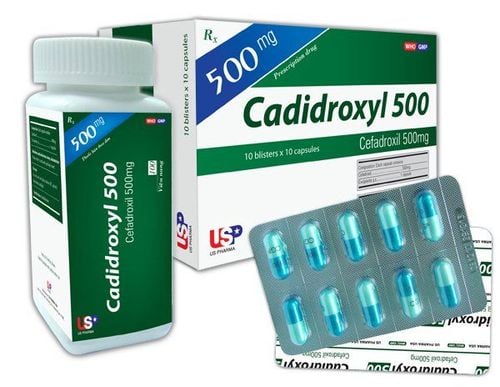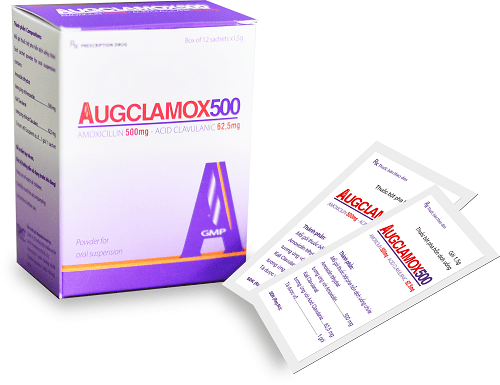This is an automatically translated article.
Besitabine is a powder for injection containing Ceftazidime, a 3rd generation Cephalosporin antibiotic. To use Besitabine safely and effectively, patients should consult a pharmacist or specialist.
1. Pharmacology of Ceftazidime
Ceftazidime is an antibiotic belonging to the 3rd generation Cephalosporin group. Ceftazidime is not absorbed from the gastrointestinal tract, so the drug is usually used intravenously or intramuscularly.
About distribution, only about 10% of Ceftazidime is bound to plasma proteins. The drug can penetrate deep tissues, including peritoneal or cerebrospinal fluid (when the meninges are inflamed). Ceftazidime also crosses the placenta and enters breast milk. Ceftazidime is not metabolized in the body. Approximately 80-90% of a dose of Ceftazidime is excreted in the urine 24 hours after dosing.
2. What is the effect of Besitabine?
Besitabine contains ceftazidime antibiotic with bactericidal effect. Ceftazidime is stable to most bacterial beta-lactamases (except Bacteroides enzymes).
Ceftazidime is sensitive to many aerobic gram-negative bacteria, even resistant to Aminoglycosides, including infections caused by Pseudomonas, E.coli, Klebsiella, Proteus, Salmonella, Shigella, Haemophilus influenzae, Pneumococcus, beta-hemolytic Streptococcus , Streptococcus viridans, Moraxella catarrhalis,... Many strains of gram-positive anaerobic bacteria that are resistant to Ampicillin or resistant to other Cephalosporins are also sensitive to Ceftazidime, Staphylococcus aureus (yellow staphylococcus) is moderately sensitive to Ceftazidime.
Ceftazidime is not effective against Methicillin-resistant Staphylococcus aureus or other bacteria such as Enterococcus, Listeria monocytogenes, Clostridium difficile, Bacteroides fragilis, Campylobacter spp.,...
A point worth noting is during treatment With ceftazidime, drug resistance can develop, especially infections caused by Pseudomonas spp, Enterobacter or Klebsiella.
3. Indications for the use of Besitabine
Besitabine is indicated in the following cases:
Lower respiratory tract infections: Pneumonia, lung abscess, bronchiolitis,... Ear, nose and throat infections: Otitis media, sinusitis, osteomyelitis mastitis,... Skin and skin structure infections: erysipelas, mastitis, abscesses, cellulitis, skin wounds, skin ulcers,... Urinary tract infections (with or without complications). symptoms): Nephritis - pyelonephritis, cystitis, prostatitis, urethritis,... Gynecological infections. Bone and joint infections: Osteoarthritis, septic arthritis,... Intra-abdominal infections: Cholangitis, cholecystitis, peritoneal abscess, peritonitis, colitis, diverticulitis, pelvic infection ,... Central nervous system infections: Meningitis,... Sepsis . Infections in other serious diseases: Secondary infections after burns, severe infections in patients with impaired immune function due to blood, infections in patients on peritoneal dialysis,...
4. Dosage and how to use Besitabine
Besitabine is prepared as a powder for injection, using the drug by mixing it with a suitable solvent and intravenous infusion or deep intramuscular injection. How to mix Besitabine solution for infusion is as follows:
Solution for intramuscular injection: Dissolve Besitabine (Ceftazidime 1g) in 3ml of distilled water for injection. Intravenous solution: Dissolve Besitabine (Ceftazidime 1g) in 10ml of distilled water for injection or it can be mixed with 0.9% sodium chloride solution or 5% dextrose solution. Solution for infusion: Solvent for solution for infusion is similar to that used for intravenous injection, but ensures a concentration of 10-20mg of Ceftazidime per ml of solution. Be careful not to mix Ceftazidime in sodium bicarbonate solution, because the drug is less stable in this solvent. After reconstitution of Ceftazidime solution, the drug should be used immediately. If not used, the solution can be stored at room temperature for 6 hours or refrigerated for no more than 72 hours. When administering intravenous injection, the injection site should be determined and injected at a slow rate, because intravenous administration of Ceftazidime in large quantities can cause vasomotor pain, sometimes leading to thrombophlebitis.
The dose of Ceftazidime is indicated depending on the infection situation, the severity of the disease, the susceptibility of the bacteria to the drug, the degree of drug response, the route of use, in addition, depending on age, weight and renal function of the patient. The usual dose of Ceftazidime for adults is 1g every 8 hours (3g/day) or 2g every 12 hours (4g/day), which can be given by intravenous infusion or deep intramuscular injection. Specifically:
Urinary tract infections or infections that are not too serious: Depending on the case, a dose of 0.5-1g every 12 hours can be used. Severe infections, especially in immunocompromised patients, including those with neutropenia: The effective dose may be 2g every 8 hours, 2g every 12 hours, or 3g every 12 hours. Pancreatic cystic fibrosis with Pseudomonas pulmonary infection: If kidney function is normal, a high dose of 100-150mg/kg/day should be used, divided into 3 times/day. For elderly patients: The usual dose should not exceed 3g/day. Use Ceftazidime for pediatric patients at the dose prescribed by the doctor. The recommended dose is as follows:
Children over 2 months of age: The usual dose of Ceftazidime is 30-100mg/kg/day, divided into 2 or 3 times. For children with impaired immune function, children with pancreatic cystic fibrosis with infection, or children with meningitis, the dose of Ceftazidime can be up to 150mg/kg/day, up to a maximum of 6g/day. Infants and children under 2 months of age: Ceftazidime dose is 25-60mg/kg/day divided into 2 times. Patients with suspected renal impairment may be initiated with a dose of 1g ceftazidime/day. Patients with renal impairment should be titrated Ceftazidime depending on creatinine clearance with the following suggested doses:
With creatinine clearance 50-31ml/min: 1 gram every 12 hours With creatinine clearance 30-16ml/min: 1 gram every 24 hours With creatinine clearance 15-6ml/min: 500mg every 24 hours With creatinine clearance <5ml/min: 500mg every 48 hours
5. Contraindications to the use of Besitabine
Besitabine is contraindicated in people with a history of shock when taking ceftazidime antibiotics or hypersensitivity to cephalosporin antibiotics.
6. Besitabine side effects
Shock: Although rare, signs of shock need to be detected and treated promptly or life-threatening. Hypersensitivity: Rash, urticaria, pruritus, erythema, flushing, angioedema,... Skin: Erythema, Lyell's syndrome, Stevens-Johnson syndrome. Nervous system: Headache, dizziness, paresthesia, decreased taste, tremor, myoclonic jerks, convulsions,... Overdosage of Ceftazidime can leave neurological sequelae such as encephalopathy, convulsions, or kissing. passionate about. Kidney: Decreased kidney function. Hematology: Increase/decrease in blood cell lines. Liver: Jaundice, increased liver enzymes. Digestion: Nausea, vomiting, diarrhea, bloody stools, loss of appetite,... Respiratory: Interstitial pneumonia, flushing, cough, difficulty breathing,... Superinfection: stomatitis, candidiasis.
7. Besitabine should be used with caution
Before using Ceftazidime, drug sensitivity should be tested to prevent bacterial resistance, as well as to ensure the minimum duration of treatment required. Patients should be examined and asked about their physical condition, history of allergies to prevent possible reactions such as allergies, shock. Pay attention to the time of using Ceftazidime because long-term use can lead to overgrowth of bacteria that are not sensitive to the drug. Use caution when using Ceftazidime in patients with renal impairment, liver failure, patients with a history of gastrointestinal disease. The safety of ceftazidime in pregnancy has not been established, therefore, it should be used only after a possible benefit/risk balance. Ceftazidime passes into breast milk, so extreme caution should be exercised when administering the drug to a nursing woman. The safety of ceftazidime in neonates and premature infants has not been established.
8. Besitabine drug interactions
Use caution when combining cephalosporin antibiotics such as ceftazidime with aminoglycoside antibiotics or with chloramphenicol. The combination of Ceftazidime with highly potent diuretics such as furosemide should also be considered. The drug may also affect the results of some laboratory tests. Patients taking Ceftazidime may have a false-positive urine glucose test with Benedict and Fehling, Clinitest. The Coomb test may also give a false-positive result in patients receiving Ceftazidime. The basic information about Besitabine in the above article is for reference only. Because Besitabine is a prescription drug, patients should not use it on their own, but need to contact a doctor/pharmacist directly to get an appropriate prescription and ensure safety for health.













